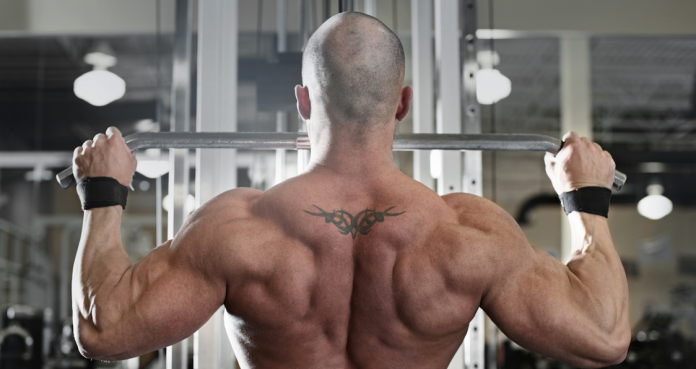Tag: tricks
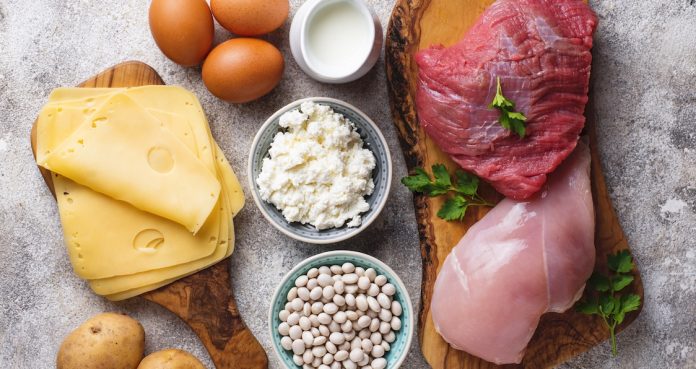
How to Eat Clean Like A Professional Bodybuilder
Having a healthy diet is one of the most impactful things you can do for your fitness.
Other than time spent in the gym, a healthy diet is the best way to promote your overall health and muscular conditioning. Supplements can be deceiving and many packaged foods at the supermarket are loaded with artificial colors and ingredients that can make you feel bloated and sluggish.
If you’re looking for inspiration on how to get started with clean, healthy eating that promotes fitness, look no further. Here’s a quick grocery list of 10 foods to help get you started with shopping and eating clean like a professional bodybuilder.
10. Dark Leafy Greens
Dark green vegetables, such as kale, broccoli, collard greens, and spinach, are extremely nutrient-rich and low in calories. They act as a great supplement or base to a heartier plate of chicken or fish. These are probably the best natural source of things like vitamin A, vitamin C, iron, fiber, vitamin K, folic acid, and so many others. It cannot be overstated what an essential source of nutrients these are in your diet.
Recommendation: Keep a bag of kale or a bag of broccoli in the fridge at all times. The kale makes a great base for a salad, while the broccoli works great in a veggie stir fry. Or switch it up based on what you like!
9. Eggs
Eggs are a versatile, protein-rich food that can be incorporated into almost any meal you could think to make — so use them! Eggs are a bodybuilder’s staple for good reason. They pack a huge punch in terms of protein (which allows your body to build muscle) without having too many calories. They’re also a great option if you’re trying to avoid an unhealthy breakfast. Eggs are completely natural — no saturated fats or unhealthy additives to slow you down.
Recommendation: Keep a carton of eggs in the fridge. You can have them for breakfast or add them to a shake for a quick protein boost.
8. Wild-Caught Fish (Salmon, Cod, Tuna)
Fish are an essential source of omega-3 fatty acids and a core component of any pro’s diet. Fish that is caught in the wild tends to have the highest amount of omega-3s, so aim for that if possible. Salmon has a higher fat content than other types of fish and can help you feel fuller for longer, potentially staving off cravings.
Recommendation: Keep salmon, cod, or tuna in the fridge and have once a week. You can bake or pan-sear as an entree, have it over rice, or put it in a salad.
7. Quinoa or Brown Rice
These grains (okay, quinoa isn’t technically a grain) make a great healthy base for a meal. They’re high in amino acids, which are essential for building muscle. If you like both, great, if not, you can easily substitute one for the other. These are also a versatile “building-block” type food like eggs that can easily be combined with other healthy foods for clean, healthy eating.
Recommendation: Keep a bag of quinoa or brown rice in your pantry. You can have chicken or fish over rice or put the rice into a salad with leafy greens — the possibilities are endless.
6. Chicken
Chicken is another bodybuilding essential. It has an astronomical protein-level for something with a comparatively low amount of fat. Again, the key here is to pick foods that can help you avoid the additives, oils, and unhealthy fats associated with processed foods. Cooking your own chicken at home with vegetables, lentils, quinoa, or brown rice is a filling, protein-rich meal.
Recommendation: Keep chicken in your fridge to have for dinner throughout the week. Combine with brown rice, collard greens, quinoa, or broccoli for a healthy dinner.
5. Dry Beans and Peas
Things like black beans, pinto beans, split peas, and lentils are all great additions to a bodybuilder’s diet. They’re easy to combine with a healthy source of protein like fish or chicken to create a meal. They’re also rich in iron and zinc which can increase joint strength.
Recommendation: Keep two bags of your favorite type of beans or peas in the pantry. They make a healthy, filling side in any meal that will keep you from snacking on unhealthier foods.
4. Greek Yogurt
An essential snack food for when you’re in-between meals, Greek yogurt is a healthy and filling option that promotes gut health and the absorption of other nutrients and minerals. Not to mention Greek yogurt is an essential source of protein.
Recommendation: Keep a pack of your favorite Greek yogurt in the fridge for snacking. You can add honey or some walnuts to add flavor and texture.
3. Olive Oil, Avocado Oil (Oils > Butter)
Try to avoid butter, which is high in saturated fats. Opt instead for cooking with olive oil, avocado oil, or another type of cooking oil.
Recommendation: Keep your favorite type of cooking oil in the pantry instead of using butter to reduce saturated fat consumption.
2. Fruits
There are a lot of different categories of fruit, but pretty much all of them are great for you. Apples, bananas, pears, and berries are high in natural sugars but ultimately much better for you than any artificially sweetened snack.
Recommendation: Keep one or two types of your favorite fruits in the kitchen to snack on, use in a salad, or make a smoothie.
1. Whey Protein
Probably the most popular protein additive in the bodybuilding world. Whey protein is clinically proven to increase gains and help the body develop muscle mass faster.
Recommendation: Keep whey protein in the kitchen. You can add it to tea, water, or as part of a healthy smoothie.
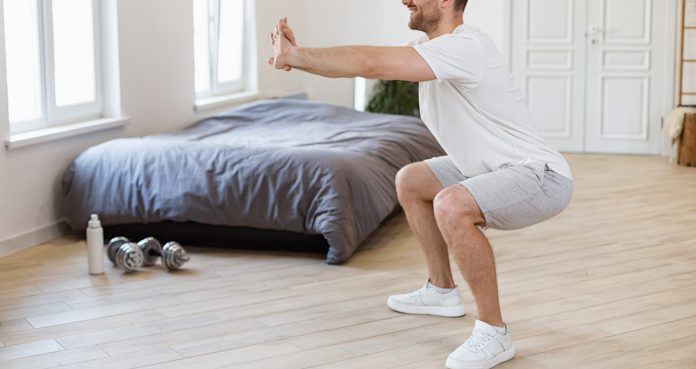
Top 5 Tips For Keeping Up With Your Cardio Indoors
There are ways to keep up with your cardio while working out at home.
Cardio might not be the most appealing type of exercise in the world, but it’s an important part of a healthy and well-rounded exercise routine. Keeping with your cardio can be a burden, but there are ways you can incorporate it into your daily workouts to make it more manageable.
If you’re still working from home, this is a great time to think about how you could incorporate exercise throughout the day since you no longer have going to the office taking up so much of your time.
Tip #1: The kettlebell is your friend.
Weight is your best friend when it comes to doing indoor cardio. Since you don’t have that much space to move around, the best trick is to utilize weights to force your body to break a sweat. The kettlebell is one of the best workout tools in this respect. You can do rapid kettlebell swings to get your heart rate up while standing in living room watching TV or on a Zoom call.
Doing twists while holding a kettlebell, when done rapidly, can also increase your cardio and help you lose weight! If you want to get serious about doing indoor cardio, definitely make sure you have one of these on hand, or an equivalent weighted tool you prefer like a medicine ball.
Tip #2: Sneak cardio into your strength training.
If you’re one of those people that absolutely dreads doing cardio, there are ways you can sneak cardio exercises into your strength training workouts. Simple modifications to common workouts are key. You could try doing five minutes of HIIT in between exercises as a way of getting cardio in while continuing to do whatever workout you normally do and enjoy.
Tip #3: Try jumping jacks, jump rope, and other ways of working out that don’t use equipment.
One of the biggest challenges of doing cardio at home is that — if you don’t have a home gym — you don’t have access to any of the fitness equipment like treadmills or rowing machines that make indoor cardio a breeze. You can still get cardio in at home with some tried and true classics like the jump rope.
Make a commitment to do fifteen minutes of jumping jacks before you start your day or before you go to bed. A jump rope is a cheap and easy way to do cardio in your house whenever you have the time. Remember, it’s the man that makes the workout, not the equipment.
Tip #4: High knees will help you break a sweat.
High knees are a cardio fundamental. It gets the blood pumping and you can do it pretty much anywhere. Plus, it burns fat in a pretty fast amount of time, so as long as you do it rapidly and with intensity you don’t even have to do it that long. Better yet, do it in small but intense bursts throughout the day to burn the most fat.
Tip #5: Don’t rely too much on HIIT for cardio, since it will disrupt your gains in strength training.
Lots of people choose HIIT as their weapon of choice when it comes to getting cardio in and it’s easy to see why. It’s quick, effective, and it gets the job done. But HIIT workouts can actually slim you down and decrease your gains from strength training since the exercises are designed to make your body more lean. If you’re trying to do cardio without sacrificing gains, make sure to not overdose on HIIT.
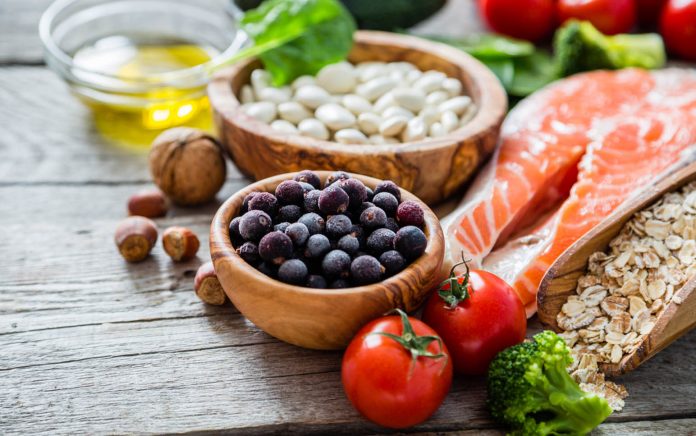
Try These Easy Exercises To Test Your Heart Health At Home
Selection of food that is good for the brain.
It can be a scary thought to visit a doctor these days, but there are still ways you can take charge of your fitness from home.
A lot of us suffer from vague anxieties about our health. Who here hasn’t had a headache and turned to WebMD to find out they have brain cancer or terminal encephalitis? Although the internet is riddled with fake news and bizarre fad diets and exercise trends that offer you too good to be true results, don’t panic: there are still ways you can take charge of your health that are based on science and are actually fairly simple.
Here are a few ways you can test your heart health from home without a trip to the doctor’s office.
How fast can you climb four flights of stairs?
A recent study done by the European Society of Cardiology found that being able to climb four flights of stairs in less than a minute is a clear indicator of good heart health.
“The stairs test is an easy way to check your heart health,” said study author Dr. Jesús Peteiro, a cardiologist at University Hospital A Coruña, Spain. “If it takes you more than one-and-a-half minutes to ascend four flights of stairs, your health is sub-optimal, and it would be a good idea to consult a doctor.”
Patients who were asked to climb four flights of stairs in under a minute and were unable to do so were far more likely to have undiagnosed coronary artery disease. If you have stairs in your house, this is a great and easy way to quickly test if your heart is relatively healthy. If you’re not able to complete this exercise, it may be a sign that something is up. However, there are many other ways you can measure your heart health from home.
Invest in an at-home blood pressure cuff or pulse monitor.
These are tools used by doctors to gather valuable metrics on the health of your heart that you can easily have in your own home. Blood pressure cuffs and pulse monitors can be used to check your heart rate and pulse before and after you work out. This can help you figure out if you’re in the optimal range for your age, gender, and weight group or not. This is also even more accurate than the stair test because it provides you with actual diagnostic criteria to understand how your heart is working.
This is obviously most relevant for those of us who work out with heart disease, but everyone can benefit from learning more about how their workouts affect their bodies. You might be surprised that your blood pressure is higher after working out than you realized — 1 in 5 adults who have high blood pressure have no symptoms and would never know without a blood pressure cuff check.
Do you find yourself getting out of breath during aerobic exercises?
This probably comes as a surprise to no one but aerobic exercises are some of the best for improving your heart health. Aerobic exercises improve the circulation of blood through your body and directly reduce your blood pressure and heart rate.
Although not as specific as the stairs test, aerobic exercises can be a great general indicator of your heart health. For example, if you find yourself unexpectedly out of breath during light aerobic exercise, you may have an underlying heart condition. This is also true if you feel extremely tired out by a light amount of aerobic exercise — there may not be enough oxygen in your blood traveling to your muscles. This isn’t an indicator alone that something is wrong, but it is something to keep an eye on.
With these three tricks in your back pocket, it should be easy to keep track of your heart health from home. But they aren’t a substitute for a real doctor if you are showing signs of having heart problems, so do make an appointment to see your doctor if it seems like something is wrong.
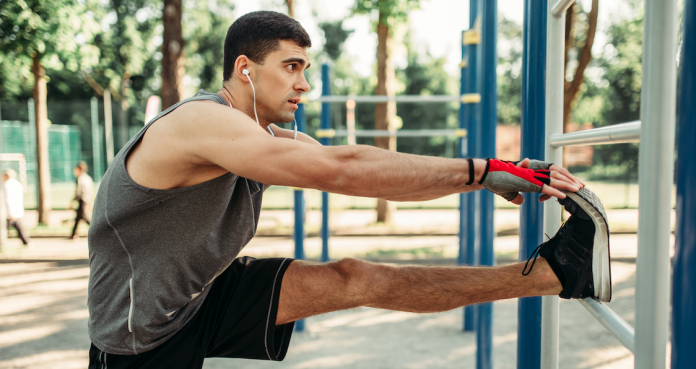
Are “Stretching Intervals” the Secret to Better Fitness?
What role does stretching play in your workout routine?
Most people in the health and fitness community will tell you that stretching is good for you, but the agreement ends there. In terms of anything more than that — how often should I stretch? What types of stretches should I be doing? Should I stretch before or after a workout, or both? — you will find thousands of camps, each with thousands of equally legitimate-sounding studies backing up whatever their personal belief is about the role of stretching in the workout.
We did a quick roundup online of what the research is really saying about stretching. Some experts even suggest that taking time to stretch during your workouts, rather than before or afterwards, is the most beneficial type of stretching you can be doing for your body.
Certified Pilates instructor Sarah James recently spoke with Well+Good to discuss her “stretch intervals” method, which consists of taking time to stretch in between reps during strength training: “It’s using time while you’re resting to get energy for your next exercise—you might as well be stretching, because you’re [using] every second of your time in a smart way.” Basically, since most of us just about collapse from exhaustion in between sets anyways, her view is that doing light stretching instead is a great way to maintain the body’s equilibrium.
The goal when working out is always to keep yourself as consistently active as possible for the duration of the workout. So, if you stretch between sets instead of lying on the floor like a beached whale, you’re doing a much better job of keeping your body fluid and in motion for as long as possible.
Another universal truth of stretching is that it increases flexibility. In the bodybuilding world, we tend to minimize flexibility as a way of thinking about the body in favor of traits we might prefer: strength, muscle mass, definition, etc. But here’s why it does matter to us: flexibility means durability.
Flexibility isn’t just useful in helping you touch your toes; flexibility helps your body heal faster, acclimates your muscles to change, and, most importantly, flexibility significantly reduces your chances of sustaining a serious injury in the gym. (At least, if you’re working out correctly, it does.) The range of motion you have in your joints shouldn’t be overlooked, whether your lifting weights or doing squats. Injuries like torn muscles, rotator cuff injuries, and even sprained ankles can keep people out of the gym for weeks or even months. So, flexibility is not only one of the core principles of fitness, it’s also an important preventive health measure.
Harvard Health gathered data from the American College of Sports Medicine on the perfect way to stretch. Their panel concluded that stretching is necessary at least two or three times a week, even for those who are not athletic, as a healthy part of body maintenance. So, for those of you who are working your bodies hard in the gym every day, stretching should be an every day thing as well, otherwise you’re not maximizing your workouts.
How do you stretch when you do your workouts? Let us know in the comments below!
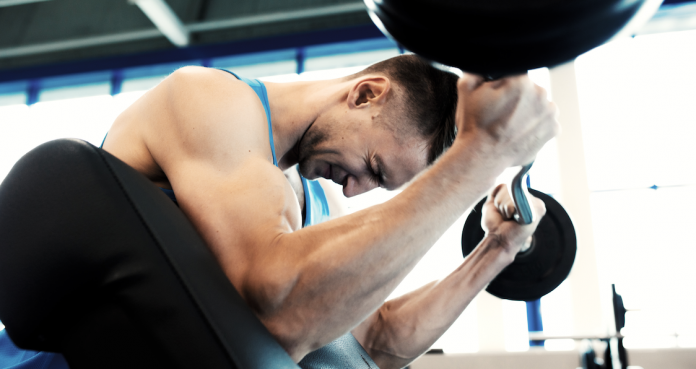
Top 5 Moves For Massive Arms
Arms are one of the cornerstones of any self-respecting bodybuilder’s workout routine.
When you picture someone working out at the gym, probably the first image that comes to mind is someone lifting weights. That’s because getting totally shredded, massive arms is basically the birthright of every bodybuilder. But are you sure that you’re getting the most gains for the energy you’re exerting? Here are the top 5 moves that are essential for making massive gains in your arms.
1. Bicep Curls
Bicep curls are probably the best exercise you can be doing to increase muscle mass in your arms. This is because they force you to keep your back completely straight as you lift, which focuses the muscular tension of your entire body down into your arms as you lift. It’s a simply exercise, but it’s a classic for a reason – it really works.
One tip for great, effective bicep curls is to increase the intensity of your workout by using a “thumb-less grip.” If you keep your thumb on the same side of the barbells as your fingers, you actually increase the workout you get all through the bicep muscle.
2. Dips
Another classic, dips are a great way to work out the arms while also feeling a nice burn in your core and upper back. It requires you to hold your spine in an upright position, so basically all of your body is getting a workout with this one, even if most of the strain is concentrated in your arms.
Dips are exhausting but, when done correctly, are one of the best arm exercises and one of the best full-body exercises overall. An important health and safety tip for dips is to make sure that your back is always straight and you are leaning a little bit forward over your hands to prevent injury.
3. Triceps Pull (Cable Machine)
The cable machine is extremely useful for arm workouts because it allows you to put your muscles to work without the extra wear-and-tear on the knees and shoulders that can come from more mechanical arm exercises. Adjust the cable machine to an amount of resistance that feels right, but still challenging, to you.
Then, do as many tricep pulls as you can – this exercise will focus right it on that area of the bicep and help to develop the musculature there. An important tip to remember for the triceps pull is that you should never lock your knees and always pull straight towards your sternum. Keeping a relaxed stance helps the tricep pull work only on your arms; anything else, and you end up getting more of a core or back workout, instead.
4. Chin-Ups
Another classic, chin-ups are a great way to maximize definition in your arms. Like some of the other exercises on this list, the key to chin-ups is to keep your back straight and really focus on using your arm muscles to lift up your torso, which should feel like a completely rigid object for the duration of the exercise.
Maintaining that control is what develops the arms so completely and fully from this exercise. A great tip for getting the most out of your chin-ups is to move at a slow, highly controlled pace. It’s easy to use your momentum coming down to swing yourself back up and over the bar, but that really doesn’t give you the best workout. Do it slowly for the ultimate burn!
5. Band Pushdowns
Pull down using a low-resistance band attached to something above you — a bar, a doorframe, etc. Just like using the cable machine to do a tricep pull, this exercise maximizes how much muscle mass you gain with minimal exertion in the joint department.
An important tip to remember when doing band pushdowns is to always scale the resistance of your band to your difficulty level. Remember, the goal isn’t to do what you’re comfortable with, but to push just beyond that. If you’re a veteran bodybuilder, you’re going to want a band with extra resistance, otherwise you simply won’t make huge gains.

